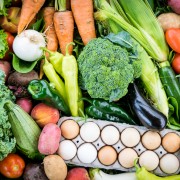Taste the Rainbow
In our fast paced, hectic world we’re often focused on quick and easy. We grab take-out because it’s simple without pausing to remember that we should eat to fuel our body and maintain our health. When we do stop to think, we often believe that taking our “one-a-day” has us covered in terms of vitamins and minerals. Oh, and since you had a banana with lunch, you’re covered – right?
Not quite. While we’ve learned that reading nutrient labels is important for understanding what’s in our packaged food, what about when food isn’t labeled that way? When you pick up an apple, or a potato, you aren’t given a key to its nutrient breakdown. Walking up and down the produce section, how are we to determine what’s what, and what we’re putting in our bodies?
First, different colored produce typically has different nutrients. For example, beta-carotene gives food an orange pigment and is thus found in carrots, sweet potatoes and pumpkin. Beta-carotene, when eaten in food, is converted by the body into Vitamin A which helps to promote healthy skin, eyes and immune systems. Potassium on the other hand is crucial for muscles to function properly, and as a result promotes healthy heart and digestive functions. Usually folks think of bananas as the star-player when it comes to natural potassium sources, but it’s also found in dark greens, sweet potatoes, tomatoes, raisins and prunes. So, an easy rule of thumb to make sure that you’re getting a good balance of food-based nutrients is to shoot for lots of color in your diet. No, we don’t mean skittles. If you eat red berries for breakfast, shoot for some greens at lunch, and some carrots with dinner. If you focus on natural color and variety at each meal, you’re well on your way to naturally fulfilling your vitamin requirements without supplements!
Secondly, it’s important to keep in mind that not all produce is created equally. An apple in the grocery store and an apple from your local orchard may not look very different, but what they offer you nutritionally can vary significantly. Nutrients develop in food as it ripens, which means that produce is healthiest when picked at peak ripeness and consumed immediately after. You know those beautiful apples that you see on grocery store shelves? They were probably bred for extended shelf-life which means they can be stored for weeks, or even months between the time that they’re harvested and when you purchase them. By the time you consume what you think is a healthful snack, stored produce has lost up to 40% of its nutrient value! Local food, with less distance from farm to table, has a smaller carbon footprint, more nutrients, and better taste than your typical grocery store produce.
When you eat local, you’re eating what’s in season where you live. This means that you’re getting produce immediately after harvest when it’s still packed with good-for-you vitamins and minerals. Plus, each season offers different crops than the last to make sure that you have access to lots of variety. A colorful plate of local food is the easiest and tastiest way to make sure you have a healthy and balanced diet.


